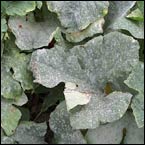Powdery
mildew
Baking soda,
sulphur or milk! The finest weapons in the fight
against powdery mildew.
 Powdery mildew is a fungal disease that is particularly prevalent
in summer and autumn when the weather is warm and dry (or in very
mild winters). Plants in conservatories and greenhouses, however,
can be infected all year round.
Powdery mildew is a fungal disease that is particularly prevalent
in summer and autumn when the weather is warm and dry (or in very
mild winters). Plants in conservatories and greenhouses, however,
can be infected all year round.
- Infected plants are
covered in a greyish-white mould, typically on upper leaf surfaces
and young shoots.
- Powdery mildews affect
a number of plants: many vegetables (beans, cucumbers, courgettes,
pumpkins, etc), fruit crop (such as apples, grapes and quinces),
sweet peas, violas/pansies, dahlias, roses, hydrangeas and African
violets, to name a few.
- There are many species
of powdery mildew and most are host specific. For example, the
one on roses will not affect cucumbers, or the one on peas will
not affect grapes.
- You may have seen
those pretty black and yellow ladybirds around, particularly if
you've got powdery mildew. These ladybirds are the only species
in NZ that are not predatory — they don't feed on aphids.
What they do feed on is fungi. But if you think these beetles
will help control powdery mildew, think again. They actually carry
spores of the disease under their wings from plant to plant.
CONTROL
The important thing to
remember here is that powdery mildew does not like wet conditions
— it's at its worst when the weather's dry. The fact that it
doesn't like water on leaves when it's developing means there are
a number of methods of controlling it that do not involve fungicide
chemicals. Anything that has a detergent type of action, or surfactants,
things that will wet the leaves, are very effective at reducing
the severity of powdery mildew.
That's why you hear people
talking about using old dishwater. Anything with a detergent in
it will actually suppress powdery mildew development.
Baking soda
One particular method that works well, particularly for
rose mildew, is baking soda. Mix up a solution of baking soda and
water and spray onto the infected plant. About half a teaspoon of
baking soda to one litre of water. Too much baking soda will burn
the leaves.
Sulphur spray
A sulphur spray is also effective against powdery mildew.
Spray fortnightly, beginning as soon as the very first sign of powdery
mildew appears, or even earlier if you know that the particular
plant gets powdery mildew every year.
Milk spray
Or you could head for the refrigerator and try a milk
spray! A weekly spray of skim milk (1 part milk, 9 parts water —
the low-fat content means there is less chance of odour) will reduce
the severity of powdery mildew by up to 90%. You see, milk is believed
to be a natural germicide; it contains a certain amount of salts
and amino acids which powdery mildew is sensitive to, and also acts
as a foliar fertiliser, boosting the plant's immune system. A word
of warning, though. If the milk concentration is above 30% (that
is, 3 parts milk), a very different fungus (albeit harmless) may
begin to grow on your plants.
Jane Wrigglesworth
Reproduced
with permission from NZOOM Home and Garden content,
from the previous
website of 
The views expressed here are not necessarily those of the RNZIH
 |
|
HOME
AND GARDEN |
|
|
More
Garden Articles
|


 Powdery mildew is a fungal disease that is particularly prevalent
in summer and autumn when the weather is warm and dry (or in very
mild winters). Plants in conservatories and greenhouses, however,
can be infected all year round.
Powdery mildew is a fungal disease that is particularly prevalent
in summer and autumn when the weather is warm and dry (or in very
mild winters). Plants in conservatories and greenhouses, however,
can be infected all year round.